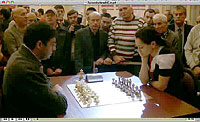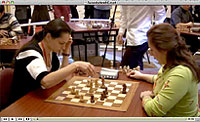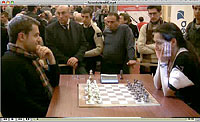Cool Chess Article: Deep Blue, Bug Conspiracy Theory and Kasparov's Loss!
Chess blog for latest chess news and chess trivia (c) Alexandra Kosteniuk, 2012
Hi everyone,
Hi everyone,
A very interesting article in Cnet talks about how a bug in Deep Blue could have actually led to Kasparov's defeat. Columnist Tim Hornyak states: "In his new book, Nate Silver writes that a glitch in IBM's chess terminator may have spooked Garry Kasparov in his famous 1997 loss. But he was more likely psyched out by its surprising brilliance."
Under pressure: The second game proved pivotal in Kasparov's 1997 match against Deep Blue.(Credit: Video screenshot by Tim Hornyak/CNET)
It's part of the conventional wisdom now that machines are smarter than us, especially when it comes to specific challenges. Chess, for instance. World champion Garry Kasparov's defeat at the hands of IBM's Deep Blue computer in 1997 was a milestone in the story of artificial intelligence.
But did the machine merely psych him out? Statistician Nate Silver's new book "The Signal and The Noise: Why So Many Predictions Fail--But Some Don't" contains an anecdote about how a glitch in Deep Blue may have led Kasparov to overestimate the machine's smarts, according to The Washington Post.
Despite the machine's ability to evaluate 200 million moves per second, Kasparov easily won the first game of the match. In the 44th move, however, Deep Blue made an inexplicable play, moving a rook for no apparent purpose.
Kasparov may have been spooked by that, but his concern turned to panic in the second game, in which Deep Blue started playing much less like a computer and more like a human grandmaster. Kasparov lost, drew the next three games, and collapsed during the sixth, losing the epic battle.
Deep Blue's rook move, however, was the result of a bug, according to Silver. The glitch made it unable to select any of the many possibilities it could analyze, so it went to a fail-safe maneuver -- a random play. The move was of no consequence, and the bug was fixed before the second game. But Silver speculates:
In fact, the bug was anything but unfortunate for Deep Blue: it was likely what allowed the computer to beat Kasparov. In the popular recounting of Kasparov's match against Deep Blue, it was the second game in which his problems originated -- when he had made the almost unprecedented error of forfeiting a position that he could probably have drawn. But what had inspired Kasparov to commit this mistake? His anxiety over Deep Blue's forty-fourth move in the first game -- the move in which the computer had moved its rook for no apparent purpose. Kasparov had concluded that the counterintuitive play must be a sign of superior intelligence. He had never considered that it was simply a bug.
What inspired Kasparov to mess up probably had a lot more to do with how Deep Blue's playing style had changed dramatically in the second game. It unexpectedly avoided a classic trap for computer players that Kasparov set, then established a winning position, prompting the world champ to resign.
Kasparov seems to have been more concerned about IBM cheating and using the advice of a hidden grandmaster than finding himself face to face with a decidedly superior intelligence. It was the first time a reigning world champion had lost to a computer in a regulation match.
The rest, of course, is history. IBM denied it had cheated, and Deep Blue was dismantled. Along with its parts went a piece of human superiority.
It's part of the conventional wisdom now that machines are smarter than us, especially when it comes to specific challenges. Chess, for instance. World champion Garry Kasparov's defeat at the hands of IBM's Deep Blue computer in 1997 was a milestone in the story of artificial intelligence.
But did the machine merely psych him out? Statistician Nate Silver's new book "The Signal and The Noise: Why So Many Predictions Fail--But Some Don't" contains an anecdote about how a glitch in Deep Blue may have led Kasparov to overestimate the machine's smarts, according to The Washington Post.
Despite the machine's ability to evaluate 200 million moves per second, Kasparov easily won the first game of the match. In the 44th move, however, Deep Blue made an inexplicable play, moving a rook for no apparent purpose.
Kasparov may have been spooked by that, but his concern turned to panic in the second game, in which Deep Blue started playing much less like a computer and more like a human grandmaster. Kasparov lost, drew the next three games, and collapsed during the sixth, losing the epic battle.
Deep Blue's rook move, however, was the result of a bug, according to Silver. The glitch made it unable to select any of the many possibilities it could analyze, so it went to a fail-safe maneuver -- a random play. The move was of no consequence, and the bug was fixed before the second game. But Silver speculates:
In fact, the bug was anything but unfortunate for Deep Blue: it was likely what allowed the computer to beat Kasparov. In the popular recounting of Kasparov's match against Deep Blue, it was the second game in which his problems originated -- when he had made the almost unprecedented error of forfeiting a position that he could probably have drawn. But what had inspired Kasparov to commit this mistake? His anxiety over Deep Blue's forty-fourth move in the first game -- the move in which the computer had moved its rook for no apparent purpose. Kasparov had concluded that the counterintuitive play must be a sign of superior intelligence. He had never considered that it was simply a bug.
What inspired Kasparov to mess up probably had a lot more to do with how Deep Blue's playing style had changed dramatically in the second game. It unexpectedly avoided a classic trap for computer players that Kasparov set, then established a winning position, prompting the world champ to resign.
Kasparov seems to have been more concerned about IBM cheating and using the advice of a hidden grandmaster than finding himself face to face with a decidedly superior intelligence. It was the first time a reigning world champion had lost to a computer in a regulation match.
The rest, of course, is history. IBM denied it had cheated, and Deep Blue was dismantled. Along with its parts went a piece of human superiority.
From Alexandra Kosteniuk's
www.chessblog.com
Also see her personal blog at
www.chessqueen.com
Don't miss
ChessQueenTV
www.chessblog.com
Also see her personal blog at
www.chessqueen.com
Don't miss
ChessQueenTV
Labels: deep blue, Garry Kasparov




































0 Comments:
Post a Comment
Note: Only a member of this blog may post a comment.
Subscribe to Post Comments [Atom]
<< Home